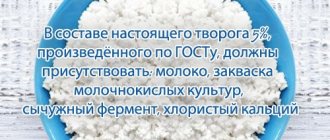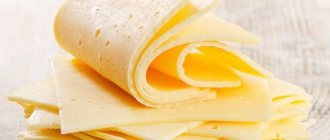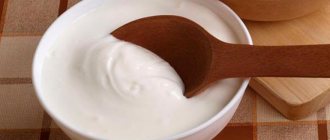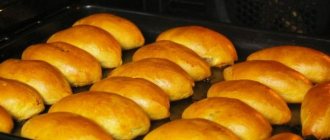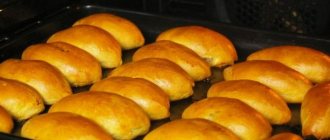The first mention of cottage cheese dates back to 1831. But according to some sources, there are claims that the first types of fermented milk product were made back in the 3rd century BC. e. A traveler walking through the desert filled a wineskin with warm sheep's milk, resulting in a curd mass under the influence of heat.
This method of preparation quickly spread throughout the ancient Roman Empire and Egypt. Today, there are many methods for calculating the calorie content of foods per 100 grams, which are popular in diets and proper nutrition. One of the essential ingredients of any diet plan is fermented milk cottage cheese.
Kinds
Usually, natural cottage cheese using traditional cooking techniques is divided into acid-rennet and acidic.
It all depends on the method of coagulation of proteins in milk and its saturation with fats. Acid-rennet curd is obtained through the use of a special enzyme (rennet or pepsin), which ensures milk coagulation during a neutral reaction with the addition of lactic acid bacteria starters for accelerated protein coagulation.
Such enzymes are widely used to produce cheeses, cottage cheese, and fermented milk products, both in the dairy industry and at home. An acidic curd product is made from skim milk by the natural coagulation of protein under the influence of lactic acid, which is obtained during the process of fermented milk fermentation.
This fermentation develops by adding additional starter to the milk.
A significant part of any type of cottage cheese contains a significant amount of liquid (up to 80%). Technologically, it is possible to obtain a fermented milk product with a low liquid content, but then it will taste dull and dry.
Depending on the properties of the raw material, there are several types of cottage cheese:
- Fat cottage cheese (12 - 23%) is the most high-calorie and nutritious type of fermented milk product, which contains complete milk protein.
- A classic product or medium-fat cottage cheese with a fat content of 4 - 10% retains all useful components as much as possible.
- A semi-fat product with a maximum fat content of about 2 - 3.8%, where all useful macro and microelements remain.
- Low-fat cottage cheese , which is the most popular in the diet menu, contains virtually no whey and has a maximum fat concentration of up to 1.8%. But when consuming this type of cottage cheese, calcium is absorbed 40% less than in other fatty varieties of the product, due to the low content of fat-soluble vitamin D. Low-fat fermented milk product also lacks vitamins E and A.
You should choose cottage cheese depending on the required protein and fat levels for each individual individually. The lower the fat content, the lower the amount of nutrients in the fermented milk product. If cottage cheese contains only 5% fat, it is ideal for dietary nutrition. In this case, its chemical composition is harmoniously combined with its nutritional value.
A product of this fat content is often recommended for children aged 6 months and older, as it is well absorbed by the child’s body, as well as for older people, due to the small amount of saturated fat.
For athletes, it is recommended to use a product with 9% fat content, because in this case protein and high calorie content are needed to gain muscle mass. For heavy physical activity, cottage cheese with 15% fat content is recommended.
What meal should you include cottage cheese in?
People without medical contraindications are allowed to include cottage cheese 5 percent (calorie content varies depending on the presence or absence of food additives) in any meal, based on individual tastes and daily routine.
Considering that cottage cheese contains a lot of protein, which takes considerable time to digest, it is best to consume it in the morning. A cottage cheese breakfast will satiate the body for several hours. If you plan to consume a dairy product in the evening, it is better to give preference to low-fat cottage cheese. This will eliminate additional stress on the pancreas.
Several reasons to eat a product with a low percentage of fat:
- cottage cheese reduces the heightened feeling of hunger after waking up;
- speeds up metabolism;
- improves sleep quality;
- eliminates unnecessary calories even during sleep, and also increases energy expenditure when the body is at rest.
Cottage cheese is one of the products that has a positive effect on a slim figure.
Calorie content, BJU
Cottage cheese (calorie content per 100 grams is calculated depending on the fat content) is considered one of the most popular fermented milk products.
Nutritional value of cottage cheese
The main ingredient in cottage cheese is the milk protein casein, which gives it its white color. This protein is absorbed more slowly and efficiently, while it helps restore and even build muscle mass, which is especially important for athletes. Interesting: 100 grams of cottage cheese contains the same amount of protein as two chicken eggs.
Cottage cheese. Calorie content and chemical composition.
Fermented milk product is low in carbohydrates, so it is often used in low-carb diets. Most of the carbohydrates in cottage cheese come from natural milk sugar and lactose and are an important component in the product, as they serve as a source of energy for the body.
Phosphorus in cottage cheese helps the body process fats and carbohydrates, and is also involved in the production of protein. Like calcium, it is important for the health of teeth and bones, paired with B vitamins, it helps to normalize the functioning of the human kidneys and nervous system. In addition, phosphorus helps balance acid levels in the body by acting as a natural alkalizing agent.
In addition to the energy and nutritional value of proteins, fats and carbohydrates, the product is rich in micro and macroelements, minerals and vitamins, which take an active part in the body's metabolic processes, and make it a complete and healthy food for any person.
The composition of cottage cheese per 100 grams of product is given in the table:
| Vitamins, mg per 100 g of product | Minerals, mg per 100 g of product | ||
| A | 42 | Calcium | 178 |
| IN 1 | 0,05 | Iron | 0,1 |
| AT 2 | 0,22 | Potassium | 218 |
| AT 3 | 1 | Magnesium | 16 |
| AT 6 | 0,12 | Sodium | 64 |
| AT 12 | 0,3 | Phosphorus | 129 |
| WITH | 0 | Iodides | 9 |
| D | 0,21 | Selenium | 9 |
| E | 0,23 | Zink | 0,5 |
Calorie content of fermented milk product
Cottage cheese (calorie content per 100 grams of product depends on the fat content in the raw materials from which the lactic acid product was made) contains the optimal amount of useful microelements. At the same time, the glycemic index of cottage cheese is quite low, about 30 units, so it is often used in medical and dietary nutrition. GI is an indicator of the effect of a food on blood sugar levels.
There are several groups:
- low GI from 0 to 55 units;
- average 56 – 69 units;
- high above 70 units.
This value, like that of cottage cheese, is comparable to the glycemic index of some green vegetables and unsweetened fruits, which makes it possible to consume it even for people suffering from diabetes.
However, it is worth remembering that when sugar, candied fruits, nuts and dried fruits are artificially added to a fermented milk product, the GI increases sharply. In addition to the fact that cottage cheese is completely absorbed by the body, it has no tissue or cellular structure and contains balanced protein.
A reference table of BZHU of different types of cottage cheese will give an idea of the nutritional value of the product:
| Indicators | Fat cottage cheese, 23% | Classic cottage cheese, 8% | Classic cottage cheese, 5% | Cottage cheese, 2% | Cottage cheese, 1% | Cottage cheese, 0% |
| Proteins, g | 9,55 | 15,0 | 17,2 | 18 | 16,3 | 16,5 |
| Fats, gr | 21,44 | 8,0 | 5 | 2 | 1 | 0 |
| Carbohydrates, g | 16,99 | 1,5 | 1,8 | 3,3 | 1,3 | 1,3 |
| Calorie content, kcal | 301,07 | 138,0 | 121 | 103 | 79 | 71 |
Calorie table for cottage cheese with 5% fat per 100 g
| Product name | Calorie content (kcal) per 100 g of cottage cheese |
| Cottage cheese 5% fat | 116,20 |
| Cottage cheese | 110,81 |
| Cottage cheese with raisins | 215,92 |
| Cottage cheese with sour cream 15% | 160,00 |
| Cottage cheese with sugar | 148,42 |
| Cottage cheese with milk 3.5% | 247,70 |
| Cottage cheese with jam | 210,56 |
Nutritional information provided is an average based on a variety of sources. The calorie content of cottage cheese from different manufacturers may differ slightly from the energy value given in the table.
Benefit
Cottage cheese (calorie content per 100 grams of fermented product, satisfies the body's daily need for most nutrients) is known for its unique properties and benefits.
In addition to the fact that adding cottage cheese to various dishes improves their taste, the lactic acid product has a number of benefits for human health:
- Improves digestion, has the ability to maintain an optimal balance of stomach acidity levels. Adding cottage cheese to your diet helps digest other foods, making it easier for the whole body to absorb food.
- Promotes weight loss; the calcium contained in cottage cheese limits the production of cortisol, which can provoke an increase in body fat.
- Cottage cheese is an excellent source of phosphorus and calcium, which helps strengthen the structure of teeth and bones. This is the most reliable source of meeting the body's calcium needs. Regular consumption of cottage cheese protects against diseases such as osteoporosis, arthritis, and reduces the likelihood of bone fractures and tooth decay.
- Due to the presence of live probiotic cultures in the product, it improves digestion processes and accelerates metabolism in the body, thereby helping to improve immunity.
- Systematic consumption of cottage cheese improves mental activity, concentration, and also increases the tone and physical activity of the body.
- The protein contained in cottage cheese is quickly absorbed and promotes the regeneration of muscle fibers, so cottage cheese is recommended for all athletes. Unlike protein meat and legumes, eating cottage cheese does not cause gas or heartburn.
- The amino acids contained in the fermented milk product, in combination with the group of B vitamins, have a beneficial effect on the central nervous system. B vitamins normalize metabolism. Vitamin B12 improves brain efficiency and helps the body absorb iron. Riboflavin converts carbohydrates into energy.
- Dairy products, especially cottage cheese, are rich in protein, calcium and vitamin D, so their regular consumption is beneficial for women's health, in particular for stabilizing hormone levels.
- Cottage cheese has restorative and healing properties; it is indicated for ulcers and gastritis, and for diseases of the endocrine system.
- Cottage cheese with a low calorie content of up to 5% per 100 grams should be consumed by children from six months and pregnant women to compensate for the lack of calcium in the body.
- Cottage cheese is good for older people, as it has the special property of strengthening joints and preventing dementia.
- Lightly salted cottage cheese helps lower blood pressure. The high content of methionine in the product helps reduce cholesterol levels in the blood. Due to this, blood circulation in the vessels improves and the risks of developing cardiovascular diseases are minimized.
- Magnesium in cottage cheese maintains normal blood sugar levels. This is a useful product for people suffering from type II diabetes, as it helps the body fight the disease and minimize its negative impact.
- The invaluable composition of cottage cheese is simply necessary for the female body. The minerals it contains, vitamin E and zinc, have a beneficial effect on the skin, nails and hair. Along with including cottage cheese in the menu, the animal product is often used as a homemade skin care product. Cottage cheese face masks make the skin soft, velvety and radiant.
- It is well suited for diets, since, despite the calorie content, the product quickly saturates the body and retains this feeling for a long time.
It is important to remember that only high quality and naturalness of the product is the main necessity for obtaining effective nutritional results. Interesting: Goat cheese contains much more calcium than its cow's milk counterpart.
Types of cottage cheese, their calorie content and nutritional value
Cottage cheese is classified into three categories: low-fat (up to 1.8 percent), semi-fat (9 percent), and full-fat (18 percent). There are intermediate subcategories, including the popular 5 percent. The calorie content of cottage cheese per 100 grams depends on the percentage of fat content. The higher it is, the greater the nutritional value of the curd mass.
Cottage cheese 5% calories
Compromise cottage cheese 5 percent has a calorie content of 121 kcal. It remains a dietary product, but has a more pleasant taste. Therefore, it is purchased for diets when they want to give up unnecessary additives. Homemade cottage cheese will have approximately the same calorie content if made with milk with 1.8 percent fat content.
The amount of protein per 100 g is reduced to 17.2 g. They are high quality and serve as an excellent basis for building muscle fibers. Proteins also help in the formation of other cells in the body.
Fat is always 5 percent. This is enough to give a pleasant taste while preserving nutrients. If the product is made at home, the percentage may vary slightly.
Cottage cheese 5% contains up to 1.8 g of carbohydrates, which is about a percent of the daily requirement. They are slowly absorbed and do not cause any harm to the figure if a person follows a strict diet. Despite the small percentage, the carbohydrates present, together with fat and protein, provide enough energy.
There are more useful substances in such a product than in a low-fat product. The composition of 5 percent cottage cheese includes the most important vitamins A and E, zinc, fluorine, copper, selenium, iron, and phosphorus. And the quality of calcium absorption increases significantly. Therefore, the product will be valuable for children during active growth of the body.
Calorie content of semi-fat cottage cheese 9%
Half-fat cottage cheese with 9 percent fat content is considered classic. Many nutritionists call it the best for proper nutrition or weight loss, as it combines moderate calorie content with a mild taste.
Nutritional value per 100 g is 159 kcal. The weight of proteins per 100 g reaches 16 g. They are slowly absorbed without loss, help strengthen muscle tissue and help during periods of increased stress. Fats are present in an average amount of 9 g. They are saturated with cephalin and lecithin, which are important for the construction of cell membranes.
Complex carbohydrates in semi-fat products increase to 2 g. Such a low figure still allows us to call a dairy product dietary and harmless for people losing weight, including those adhering to a ketogenic diet.
The presence of an increased number of vitamins makes the semi-fat curd mass more valuable for humans. Its composition is also characterized by an increased amount of calcium. To get the maximum benefit, it is recommended to avoid unnecessary additives, including sour cream, sweets, and fruits. They will increase the calorie content with the percentage of fat and affect the value of the dish.
Cottage cheese 18 percent fat
The calorie content of the 18% product is 232 kcal per 100 g. It is the most correct and complete type, which is confirmed by the recommendations of nutritionists. Despite the percentage of fat content, it cannot be called harmful in the diet when losing weight.
The volume of protein per 100 g is reduced to 15%. Its quality is no different from other types of fat, it is fully absorbed and used by the body to build new vital cells. The fat content increased to 18 g does not have a negative effect. The curd mass becomes pleasant to the taste, it can be comfortably eaten without unnecessary additives.
Cottage cheese with 18 percent fat content has 2.8 g of carbohydrates per 100 g. This is still not enough to provide the body with the daily requirement, but is still not harmful to the diet menu.
The increased amount of methionine is of particular value. This amino acid helps prevent unwanted fatty liver disease. It can also speed up recovery in children whose bodies are weakened after illness.
A contraindication for use can only be kidney pathology.
Calcined
The calorie content of a calcined product is practically no different from a semi-fat one. It provides the body with nutritional value of up to 160 kcal. The product differs in protein to a greater extent - 16.7 g. It is as complete and useful for strengthening physical fitness as in other types. Its growth is associated with a slight change in composition.
The fat content of cottage cheese is 9 percent, the same as semi-fat. Therefore, it can be eaten without additional ingredients without experiencing negative feelings. The taste remains unchanged and pleasant. The calcined product contains about 2 g of carbohydrates. In terms of quality and dietary compatibility, it does not differ from traditional ones.
The composition contains additional calcium added to the milk at the production stage. Therefore, this type of curd is especially useful for bone problems or injuries. However, it should be consumed sparingly, since even with a low calorie content, an excess of calcium will lead to metabolic disorders.
Cottage cheese from skim milk
Skim milk is the low-calorie skim milk left over from creaming. It is characterized by an increased amount of protein and value, which affects the nutritional value. The calorie content of skim milk curd is 136 kcal.
Per 100 g there is up to 20% protein. This increased percentage is achieved precisely from the return. This does not deteriorate the structural composition. The presence of fat remains at 2 percent. Therefore, the curd mass is a little dry, crumbly and dense. Eating it is sometimes difficult and not so tasty. Carbohydrates increase to 7 g, which is about 5 percent of the daily value. They still belong to the complex category and do not harm the diet.
Skim curd yields increased amounts of zinc, copper, potassium and calcium. Its general vitamin and mineral composition is similar to other types of fat and remains no less valuable. Substances missing from low-fat grains are present here in moderate amounts.
Harm
Cottage cheese is a fairly versatile product that has a number of benefits, especially for people who are lactose intolerant. Although the product helps reduce weight, regular use may lead to weight gain. It can also be quite a heavy product for people with gastrointestinal diseases and a tendency to constipation.
In people suffering from arthritis, intensive consumption of cottage cheese can trigger the development of joint pain. The sodium content in 100 grams of fermented milk product is 40% of the body's daily requirement for this microelement, which plays an important role in maintaining optimal water-salt balance in cells.
With excess sodium, some negative aspects may appear in the form of:
- water retention;
- swelling;
- swelling;
- weight gain.
Such side effects may be temporary, but with frequent cottage cheese diets, when the product becomes the main source of nutrition and excessive amounts of sodium enter the body, quite complex problems can develop.
Namely:
- high blood pressure;
- kidney dysfunction;
- heart failure;
- risks of heart attack and stroke.
Cottage cheese does not contain fiber. The recommended daily intake of dietary fiber is 25 grams for women aged 19 to 50 years and 40 grams for men aged 19 to 55 years. Lack of fiber negatively affects the functioning of the gastrointestinal tract and can lead to the development of constipation, diabetes, vascular atherosclerosis and other undesirable consequences.
Important: such problems can only arise with systematic consumption of cottage cheese, without adding additional foods to the diet. The recommended daily dose of the product should not exceed 250 grams.
Harm of cottage cheese to the human body
Despite all the benefits, you need to remember that there is a flip side to the coin. The product may cause harm to the body in the following cases:
- Food poisoning. Is it possible to get poisoned from cottage cheese, of course, if you violate the rules for storing it? All fermented milk products quickly deteriorate if left outside the refrigerator. This is an excellent breeding ground for E. coli. It can be stored for no more than three days from the date on the package at the indicated temperature. When buying a village product, there is also a high probability of getting cottage cheese poisoning. You need to know the seller personally and be confident in his integrity and cleanliness.
- High calorie fatty product. It is necessary to control the amount in order to eliminate the negative impact on the kidneys and liver due to the high protein and salt content. Hypertensive patients should also remember the measure, since salt retains fluid in the body, which means there is a risk of a jump in blood pressure.
- Allergy to cottage cheese. This reaction of the body is not that uncommon. Lactose intolerance is now common among children and women.
So, cottage cheese is the recognized king of therapeutic nutrition. It is rich in minerals, vitamins and protein. It is useful for people at any age, helps to cope with many diseases, and keep your figure in shape. The taste of this product is familiar to everyone from an early age and to most adults - mother’s cheesecakes will always remain a favorite dish. And it is important to remember that any food, including cottage cheese, should be consumed in moderation.
Contraindications
It is prohibited to consume fermented milk products of animal origin in case of individual intolerance, allergic reactions to cow protein, atherosclerosis and serious kidney diseases.
It is also worth considering expiration dates, storage conditions and freshness of the product, otherwise poisoning may not be avoided.
Benefits of cottage cheese for human health
If we briefly describe the benefits of cottage cheese, we get three important points:
- Cottage cheese contains vitamins A, B1, B2, C, E, PP and the basic amino acids methionine and tryptophan, which promote hematopoiesis and normalize the activity of the nervous system.
- It also contains beta-carotene, which normalizes metabolism in the body, as well as a large number of microelements necessary for the normal functioning of the human body (potassium, magnesium, iron, zinc, phosphorus, fluorine, selenium, etc.).
- Unlike components of other foods of animal origin, curd protein has neutral acidity and is easily digestible. It uses less gastric juice and enzymes to digest it, so it is suitable even for people with diseases of the gastrointestinal tract and is the basis of many diets.
Menu for diet
The cottage cheese diet is a short diet designed to quickly lose a couple of extra pounds. Nutritionists do not recommend giving preference to low-fat cottage cheese when dieting and proper nutrition, since the body will not receive enough essential nutrients.
It is best to opt for a fermented milk product with 2 to 5% fat content. It is preferable to eat the treat in the first half of the day, or better yet, for breakfast, then the body will need at least two hours to digest the product.
Advantages and disadvantages
The obvious benefit of the cottage cheese diet is that it really works, since a sharp reduction in calories and giving up fast carbohydrates helps you easily lose weight in a short period. This diet is most often designed for a short period of time, from three to seven days. It is easy to follow and does not require complex recipes.
At the same time, a diet high in protein helps you feel fuller longer and reduces the likelihood of overeating. Like any dietary restriction, the cottage cheese diet has its drawbacks. If you eat only cottage cheese during the day, the body will not receive all the nutrients necessary for its normal functioning.
In the long term, low-calorie diets such as the cottage cheese diet can cause fatigue, nausea, a general feeling of weakness, loss of muscle tissue, which in turn provokes a slowdown in the body's metabolism and loss of cellular water balance.
Menu for the week
Cottage cheese (calorie content increases per 100 grams when adding fresh fruits, nuts or seeds) will help you lose a couple of extra pounds if you just need to fit into a little black dress for the holiday. To further enrich your diet with nutrients, you can diversify your diet with foods high in fiber.
It is also necessary to drink enough water or decoctions throughout the day. There are no official versions of cottage cheese diets; this implies a nutrition plan where you can eat cottage cheese with every meal for at least three days.
You should avoid alcohol, carbonated and sweetened drinks, and fruit juices. Today, the fermented milk product is successfully used in salads, baked dishes, confectionery, sandwiches, omelettes, salad dressings and baked goods. Cottage cheese can be combined with fish, meat, eggs, vegetables and mushrooms.
One of the cottage cheese diet options is shown in the table:
| № | Products | Description | Nutritional value, BJU/Kcal per 100 g of product |
| 1 day | Cottage cheese 260 g, lettuce 2 bunches, apples 2 pcs. | Using a blender, beat all ingredients, add 2 teaspoons of lemon juice, salt and pepper to taste. The finished sauce can be consumed with rye bread, potatoes - 100 g, ham - 160 g. | 8,14/8,91/4,92/133,41 |
| Day 2 | Baked cod fillet - 200 g, cottage cheese - 200 g, pickles - 100 g, chicken egg, potatoes - 300 g, parsley. | Cottage cheese mixed with parsley, finely chopped egg and pickles, eat three times a day with potatoes and fish | 9,69/2,61/14,84/124 |
| Day 3 | Cottage cheese - 200 g, grated cheese - 40 g, green peas - 100 g, cauliflower - 200 g, boiled carrots - 400 g, egg whites - 2 pcs. | Vegetables are cut into small pieces, laid out in a mold, and topped with a mixture of cottage cheese, grated cheese and egg whites. Baked in the oven for 30 minutes | 6,22/3,23/4,94/72,66 |
| 4 day | Cottage cheese - 200 g, grated cheese - 40 g, bread - 100 g. | The cheese is grated, seasoned with pepper and salt, mixed with cottage cheese and spread on bread. | 15,04/9,06/15,56/207,41 |
| 5 day | Cottage cheese - 300 g, strawberries - 200 g, lemon juice - 1 tbsp, muesli - 100 g. | Cut the strawberries, lay them out in layers: muesli, cottage cheese and berries. Sprinkle with lemon juice. | 10,29/5,65/14,66/149,71 |
| Day 6 | Cottage cheese - 250 g, yolks - 2 pcs, semolina - 0.5 cups, rhubarb root - 200 g, starch - 1 tbsp. | Mix cottage cheese with yolks, add semolina and egg whites. Pre-boil the chopped rhubarb for two minutes and add to the total mass. Bake the casserole in the oven for 30 minutes | 9,65/6/14,7/152,78 |
| Day 7 | Oatmeal - 300 g, cottage cheese - 150 g, apples - 2 pcs, banana - 1 pc. | Oatmeal can be mixed with cottage cheese and an apple or any other fruit. | 4,16/2,26/11,72/85,63 |
How to use on a diet
Since cottage cheese is rich in nutrients, it is recommended to include it in the diet during a diet.
Example of a diet based on cottage cheese with low calorie content (5%)How to use:
- The fermented milk product has a minimal amount of fat and enough protein. For an evening meal, a vegetable salad of greens, cucumbers and tomatoes with the addition of this product is perfect.
- It is better not to use cottage cheese with 0% fat content either when fighting excess weight or when following proper nutrition standards. A healthy body needs fats. If there is a shortage of them, men may develop sexual impotence, and girls may experience infertility or problems with bearing a child. That is why cottage cheese with a fat content of up to 5 percent and a moderate calorie content is best suited for use on a diet. In the process of losing weight, the daily intake of 5% cottage cheese is up to 0.5 kg per day. This dish contains about 120 kcal. This will not affect your figure, even if you mix the product with berries, vegetables or lettuce.
- To add to cottage cheese, it is better to choose vegetables that do not contain starch (beets, cucumbers, carrots, tomatoes).
- It can be consumed as a separate dish or made into a healthy smoothie. To do this, just blend the cottage cheese and berries (both frozen and fresh) with a blender. As a healthy snack, you can mix parsley or dill with cottage cheese and spread the resulting mixture on bread.
- You can prepare casseroles or cheesecakes with minimal addition of harmful products. A good option would be cottage cheese muffins with oatmeal, pumpkin or zucchini.
An example of a cottage cheese diet designed for 3 days:
- morning meal: tea without sugar, 0.5 grapefruit, 1 soft-boiled egg;
- lunch: 250 g soft cottage cheese, 1 medium-sized tomato, unsweetened tea;
- evening menu: vegetable salad dressed with olive oil, package of cottage cheese, tea without added sugar.
On such a diet you can get rid of a couple of kilograms in just 3 days.
When to expect an effect
How long the cottage cheese diet lasts is an individual choice. Real changes can be noticed already on the third day. But you can’t torture yourself to the point of fainting from hunger. After all, any diet will be effective if you supplement it with feasible physical activity, walking or regular gymnastics at home.
Contraindications for the diet apply to those who have allergic reactions to dairy products, kidney and liver diseases, and metabolic disorders. The diet should not be used by pregnant or lactating women, as well as adolescents under 18 years of age.
The success of any diet involves not only calculating calorie content per 100 grams, but also choosing quality products. Therefore, when purchasing homemade cottage cheese, it is important to know that a bitter taste will indicate low quality milk, and a sour taste indicates that the product is not fresh.
When the curd mass is hard, such curd was prepared in violation of technology, which means it does not contain useful vitamins and most microelements. If you rub the cottage cheese between your fingers, you will get an oily liquid that will roll into lumps. A low quality product will feel sticky to the touch.
Benefits and contraindications of low-fat cottage cheese
A classic dietary option is cottage cheese made from low-fat milk. This product is low in calories while maintaining protein value.
This component is often prescribed as an auxiliary dietary supplement in the treatment of a number of diseases:
- diabetes mellitus;
- heart disorders;
- obesity;
- hypertension;
- pathologies of the gastrointestinal tract (ulcers, colitis, enteritis);
- atherosclerosis;
- damage to the gallbladder and liver.
The healing effect is due to the beneficial properties of the product:
- low-fat cottage cheese improves intestinal motility;
- restores lipid balance and general metabolism;
- stimulates brain activity;
- strengthens bones, improves the condition of hair and nails;
- normalizes the functioning of the central nervous system;
- serves as a prevention of oncology;
- increases hemoglobin levels in the blood;
- has a beneficial effect on the thyroid gland.
Cottage cheese is a source of phosphorus and calcium. The protein contained in the product is perfectly balanced in amino acid composition. Finally, the real benefit of low-calorie cottage cheese for the body is the presence of fermented milk bacteria in it, which ensure “order” in the intestinal flora.
Contraindications for use are associated with reduced digestibility. A minimal amount of milk fat leads to the fact that the product contains little cephalin, phospholipids and lecithin, which are involved in the transmission of nerve impulses. This “minus” can lead to metabolic disorders.
Another disadvantage of low fat (vitamin D) is the body's reduced ability to absorb calcium. Low-fat cottage cheese is considered a “poor” source of fat-soluble vitamins. The above disadvantages cannot be considered significant and can cause harm to the body if a person eats rationally and variedly.
